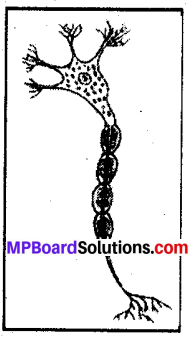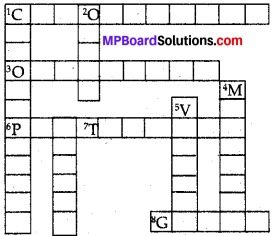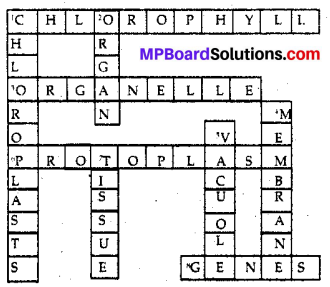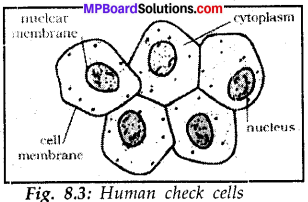In this article, we will share MP Board Class 8th Science Solutions Chapter 8 Cell – Structure and Functions Pdf, These solutions are solved subject experts from the latest edition books.
MP Board Class 8th Science Solutions Chapter 8 Cell – Structure and Functions
MP Board Class 8th Science Cell – Structure and Functions NCERT Textbook Exercises
Mp Board Class 8 Science Chapter 8 Question 1.
Indicate whether the following statements are True (T) or False (F).
(a) Unicellular organisms have one-celled body. (T/F)
(b) Muscle cells are branched. (T/F)
(c) The basic living unit of an organism is an organ. (T/F)
(d) Amoeba has irregular shape. (T/F)
Answer:
(a) True
(b) False
(c) False
(d) True
Mp Board Class 8 Science Solution Chapter 8 Question 2.
Make a sketch of the human nerve cell. What function do nerve cells perform?
Answer:
The nerve cells receive and transfer

messages, thereby helping to control and coordinate the working of different parts of the body. See the figure given below right:
Class 8 Science Chapter 8 Mp Board Question 3.
Write short notes on the following:
(a) Cytoplasm
(b) Nucleus of a cell.
Answer:
(a) Cytoplasm: It is the jelly-like substance present between the nucleus and the cell membrane. It contains nucleus and many small structures called organelles. Cytoplasm, along with nucleoplasm, forms the living substance of the cell, called the protoplasm.
(b) Nucleus: It is an important component of the living cell. It is generally spherical and located in the centre of the cell. It can be stained and seen easily with the help of a microscope. Nucleus is separated from the cytoplasm by a membrane called the nuclear membrane. The liquid substance of the nucleus is termed as nucleoplasm.
Mp Board Solution Class 8 Science Chapter 8 Question 4.
Which part of the cell contains organelles?
Answer:
Cytoplasm of the cell contains organelles.
Mp Board Class 8 Chapter 8 Question 5.
Make sketches of animal and plant cells. State three differences between them.
Answer:

Difference between plant cell and animal cell.

Mp Board Class 8 Social Science Solution Chapter 8 Question 6.
State the difference between eukaryotes and prokaryotes.
Answer:

Mp Board Solution Class 8 Science Question 7.
Where are chromosomes found in a cell? State their function?
Answer:
Chromosomes are found in the nucleus of the cell as thread like structures. They carry genes on them that help in the transfer of characters from the parents to the next generation. Thus, chromosomes play a very important role in inheritance.
Mp Board Class 8 Science Solution Question 8.
‘Cells are the basic structural units of living organisms’. Explain.
Answer:
Cells may be compared to bricks. Bricks are assembled in a proper way to make a building. Similarly, cells are assembled to make the body of every organism. There are millions of living organisms. They are of different shapes and sizes. An organism with billions of cells begins life as a single cell which is a fertilised egg. The fertilised egg cell multiplies and the number of cells increase as development proceeds. So, cell is called the basic structural unit of living organisms.
Mp Board 8th Class Science Solutions Question 9.
Explain why chloroplasts are found only in plant cells?
Answer:
Chloroplasts are the green coloured plastids. They contain chlorophyll which synthesise food in plants by the process of photosynthesis. They are not found in the animal cell. They provide green colour to the leaves. Hence, chloroplasts are found only in plant cells.
Mp Board Class 8 Science Question 10.
Complete the crossword with the help of clues given below:
Across
1. This is necessary for photosynthesis.
3. Term for component present in the cytoplasm.
6. The living substance in the cell.
8. Units of inheritance present on the chromosomes.

Down
1. Green plastids.
2. Formed by collection of tissues.
4. It separates the contents of the cell from the surrounding medium.
5. Empty structure in the cytoplasm.
7. A group of cells.

MP Board Class 8th Science Cell – Structure and Functions NCERT Extended Learning – Activities and Projects
Class 8 Science Chapter 8 Question 1.
Visit a laboratory for senior secondary students in your school or in a neighbouring school. Learn about the functioning of a microscope in the laboratory. Also observe how a slide is observed under the microscope.
Answer:
Do yourself.
Mp Board Class 8 Science Solution English Medium Question 2.
Talk to the senior biology teacher in your school or a neighbouring school. Find out if there are diseases which are passed on from parents to the offspring. Find out how these are carried and also if these diseases can be treated. For this you can also visit a doctor.
Answer:
There are certain diseases which are passed on from parents to the offspring. Diseases like diabites, heart diseases, certain skin diseases like leukoderma, etc. are genetic diseases.
Mp Board Solution Class 8 Question 3.
Visit an agriculture extension centre in your area. Find out about genetically modified (GM) crops. Prepare a short speech for your class on this topic.
Answer:
Do yourself.
Class 8 Science Mp Board Question 4.
Find out about Bt cotton from an agriculture expert. Prepare a short note on its advantages/disadvantages.
Answer:
Do yourself.
MP Board Class 8th Science Cell – Structure and Functions NCERT Additional Important Questions
A. Short Answer Type Questions
Mp Board Class 8th Science Solution Question 1.
Define a cell.
Answer:
A cell is the basic unit of living things.
Class 8th Science Mp Board Question 2.
Who discovered cell?
Answer:
Robert Hooke discovered cell.
Class 8 Mp Board Science Solution Question 3.
Give importance of Chromosomes.
Answer:
They contain all the informations necessary for the cell to function and to reproduce further cell for the next generation.
Class 8 Science Solution Mp Board Question 4.
What is gene? What does it control?
Answer:
Gene is a unit of inheritance in living organisms. It controls the transfer of a hereditary characteristic from parents to offspring.
Class 8th Science Lesson 8 Question 5.
How do plants cell differ from animal cell?
Answer:
Plants cell differ from animal cells in having an additional layer around the cell membrane termed cell wall.
B. Long Answer Type Questions
Mp Board Class 8 Science Solution In English Question 6.
Give the main features of nerve cell.
Answer:
The main features of nerve cell are:
- This tissue forms the brain, spinal cord and nerves.
- Each cell is called neuron.
- Neuron is a cell specialized to conduct impluses.
- Each neuron consists of a cell body or cyton and a long rod like structure called axon.
Class 8th Science Chapter 8 Question Answer Question 7.
Which is the largest cell in our body? What is the utility of its length?
Answer:
The largest cell in our body is nerve cell. The projections in nerve cells help them to be in close contact with the muscles and other tissues so that the messages may be passed very easily to the concerned tissues.
8th Class Mp Board Science Question 8.
Draw a neat sketch of human cheek cells.
Answer:

8 वी विज्ञान गाईड Pdf Question 9.
What do you mean by gene? Explain.
Answer:
Gene is a unit of inheritance in living organisms. It controls the transfer of a hereditary characteristics from parents to offspring. This means that your parents pass some of their characteristics on to you. If your father has brown eyes, you may also have brown eyes. If your mother has curly hair, you might also end up having curly hair. However, the different combination of genes from parents result in different characteristics.
Question 10.
Describe the structure which are seen only in plants?
Answer:
The following structures are seen only in plants:
- Cell wall. The outer covering of a cell is called cell wall. It is made up of chemical substance called cellulose. It maintains the shape of cell and offers rigidity. It is premeable to certain substances.
- Plastids: These are small dot-like structures which are seen near the nucleus in the ground plant cells, and meant for photosynthesis.
- Other substances: These substances may be either reserve food or secretory or excretory products.